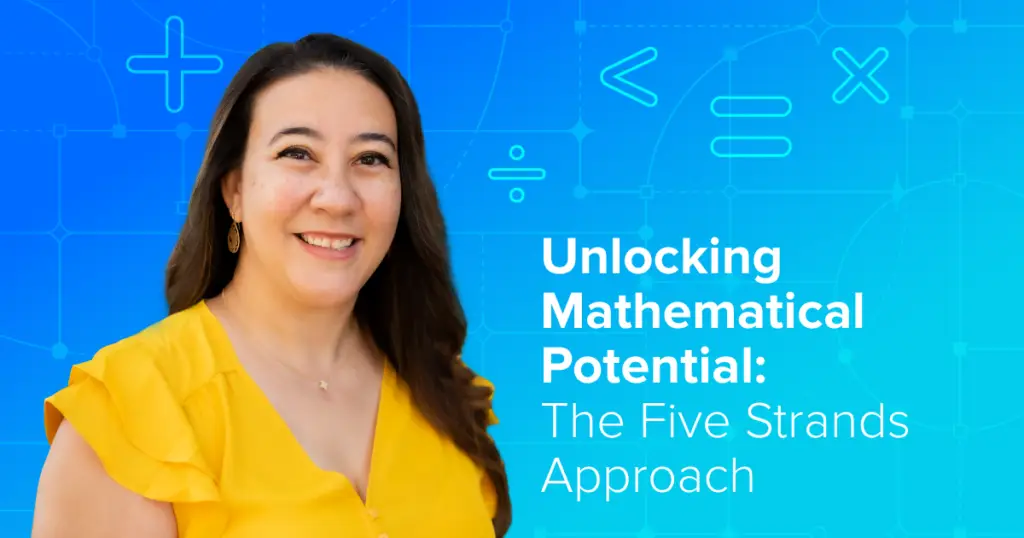The five strands of mathematical proficiency—productive disposition, conceptual understanding, procedural fluency, strategic competence, and adaptive reasoning—form the foundation of a comprehensive approach to math education (National Research Council, 2001). At Age of Learning, we’ve seen how integrating these strands creates confident, creative problem-solvers who see math as a powerful tool rather than an obstacle.
By Naomi Church, National Curriculum Specialist, Math
As a curriculum expert at Age of Learning, I’ve seen how the right approach can transform math education. Today, I’m excited to share a powerful framework that’s revolutionizing how we teach and learn mathematics: the five strands of mathematical proficiency. These strands—productive disposition, conceptual understanding, procedural fluency, strategic competence, and adaptive reasoning—work together like strands of a rope, creating a strong foundation for mathematical success.
By focusing on these key components, we can nurture well-rounded, capable students who are equipped to thrive in our increasingly math-reliant world. Understanding these five strands can be a game-changer in supporting students’ math journeys. Let’s explore how we can elevate math education and set our students up for success!
Fostering a Productive Disposition
A productive disposition involves seeing math as sensible, useful, worthwhile, and doable (National Research Council, 2001). This positive mindset is crucial for building a strong mathematical foundation. Providing opportunities for students to make sense of math and experience the rewards of perseverance boosts their confidence and self-efficacy. The use of “just in time” scaffolds can ensure that students are successful with the least amount of supports possible. Game-based learning and positive reinforcement further enhance this disposition, making math an engaging and rewarding experience.
Building Conceptual Understanding
Conceptual understanding means deeply grasping mathematical concepts, operations, relations, and ideas (National Research Council, 2001). Students who connect new ideas to their existing knowledge are better equipped for long-term retention and application. Effective instruction builds on what students already know and uses tools like instructional videos and peer models to explain complex concepts. This deep understanding is essential for true mathematical proficiency.
Developing Procedural Fluency
Procedural fluency is the ability to perform mathematical procedures efficiently, flexibly, appropriately, and accurately (National Research Council, 2001). Research supports combining fact strategy instruction with mastery practice activities to aid in the development of both number sense and basic fact fluency (Morano, Randolph, Markelz, and Church, 2020). Regular practice with immediate feedback is key to mastering these skills. Engaging students in play-based learning makes mastery practice enjoyable and effective, helping them internalize procedures and apply them confidently in different contexts.
Enhancing Strategic Competence
Strategic competence involves the ability to formulate mathematical problems, represent them and then solve them thoughtfully (National Research Council, 2001). Providing meaningful problem-solving opportunities and teaching systematic strategies are crucial for developing this competence. Meaningful and relevant real-world problems engage students as well as encourage critical thinking, fostering strong problem-solving skills.
Nurturing Adaptive Reasoning
Adaptive reasoning is about logical thought, reflection, and justification. Encouraging students to discuss concepts, explain their thinking, and justify their answers enhances these skills. Small-group and one-on-one lessons allow for in-depth discussions, helping students refine their reasoning abilities and engage in meaningful mathematical discourse.
The five strands of mathematical proficiency—productive disposition, conceptual understanding, procedural fluency, strategic competence, and adaptive reasoning—form the foundation of a comprehensive approach to math education (National Research Council, 2001). At Age of Learning, we’ve seen how integrating these strands creates confident, creative problem-solvers who see math as a powerful tool rather than an obstacle.
Our My Math Academy program exemplifies this approach, leveraging adaptive technology to personalize learning experiences that cultivate all five strands simultaneously. By presenting engaging, real-world challenges, My Math Academy fosters a productive disposition towards mathematics while building conceptual understanding, procedural fluency and strategic competence. The program’s just-in-time scaffolding also contribute to a productive disposition, allowing students to tackle increasingly complex problems with confidence. By weaving these elements into our teaching and learning environments through innovative platforms like My Math Academy, we’re not just helping students excel in math; we’re equipping them with skills that extend far beyond the classroom.
Additional Resources
- Strengths-Based Teaching and Learning in Mathematics: 5 Teaching Turnarounds for Grades K-6 – Corwin and NCTM joint publication

